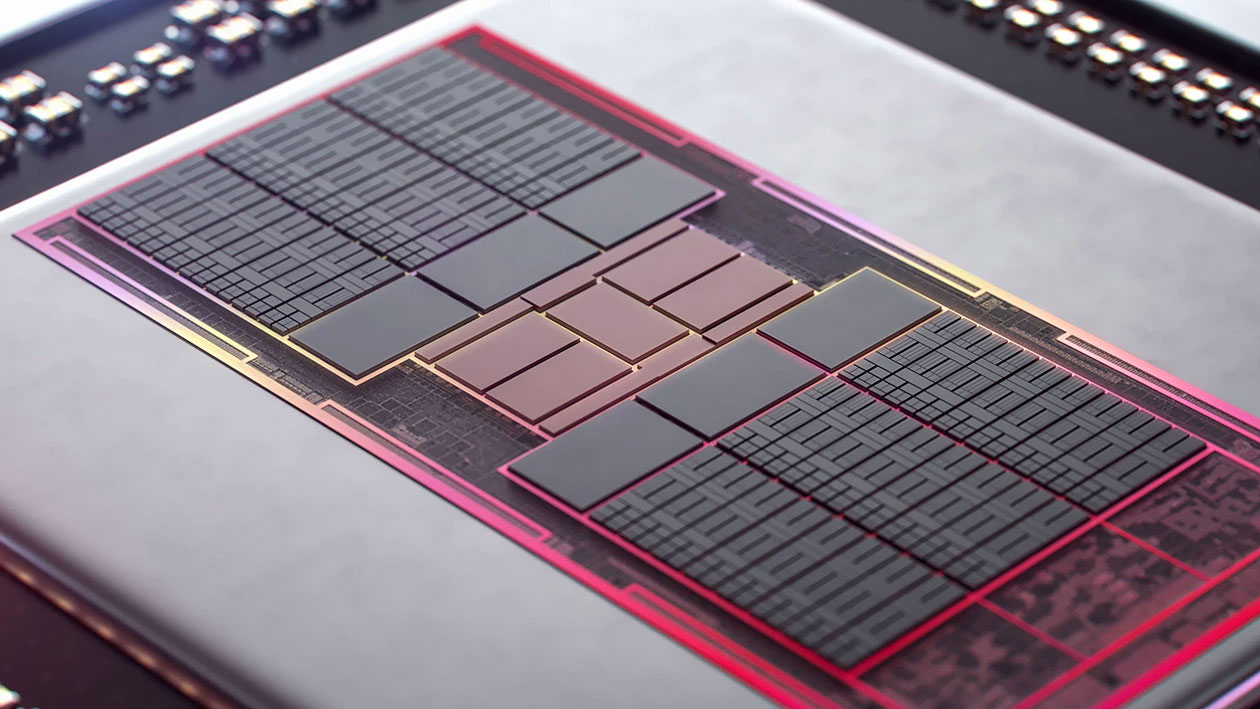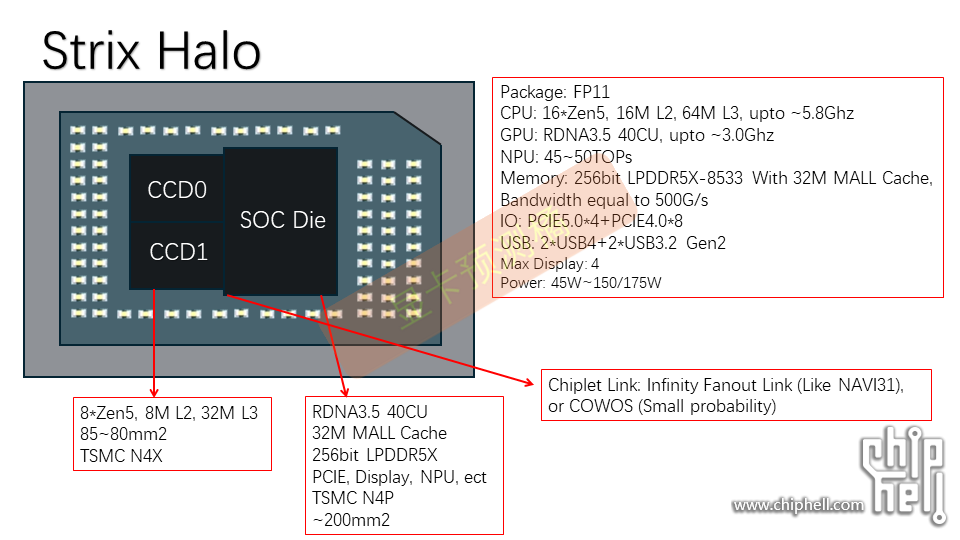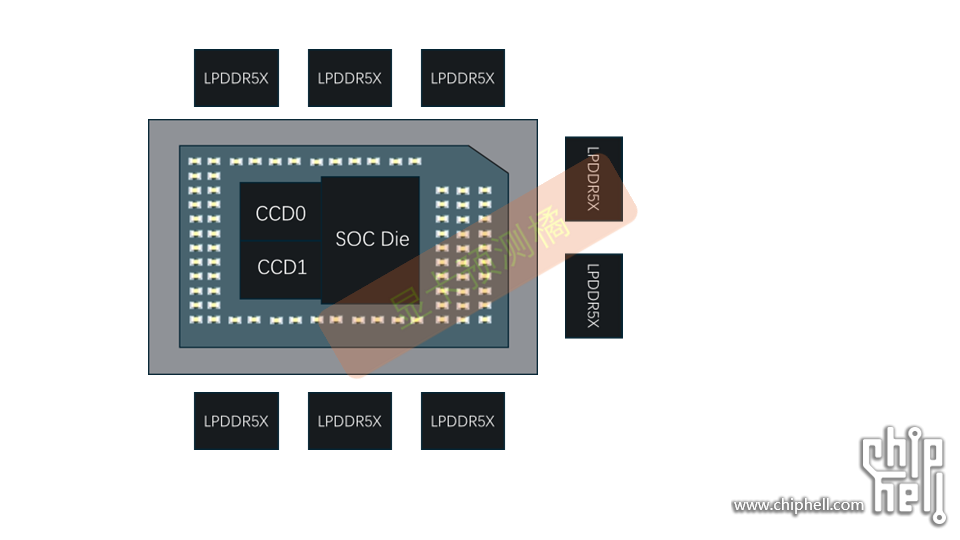Alleged Zen 5 'Strix Halo' Mobile APU has more GPU cores than RX 7600 XT or PS5 — features monster RDNA 3.5 GPU with 40 compute units
Strix Point looks to be super potent, assuming this is even remotely accurate information.

A user on the Chiphell forums has apparently spilled the beans on the upcoming "Strix Halo" Zen 5 APU, allegedly leaking detailed specifications and schematics of AMD's new CPU design. The images seemingly confirm that the Strix Halo chips will use a multi-chiplet approach comprised of two Zen 5 CCDs and an SoC die incorporating a massive RDNA 3.5 GPU that features more graphics compute units than either the PS5 or an RX 7600 XT.
Before going any further, it's worth mentioning that these are allegedly leaked details of Strix Halo. The original poster even stated that some of the information is speculative. So take this information with a huge grain of salt. We'll cover the information here, but it's entirely possible and even likely that much of this is bogus.


Strix Halo is shaping up to be the most powerful Accelerated Processing Unit (APU) AMD has ever produced, even when compared with its console counterparts. The high-performance APU will reportedly ship with 16 Zen 5 CPU cores that turbo up to 5.8 GHz along with 16MB L2 cache and a 64MB L3 cache. In addition, the SoC die supposedly sports an additional 32MB "L4 Cache" that the CPU and GPU share.
Strix Halo will also come with an updated XDNA NPU that reportedly has 45 to 50 TOPS of performance, surpassing Microsoft's minimum requirement for AI PCs. The memory interface will consist of either eight 32-bit LPDDR5X memory modules spaced all around the APU (just like on the PS5/Xbox Series X/S) or four 64-bit LPDDR5 DRAM modules in the same configuration. Either way, both configurations will give the Strix Halo APU a 256-bit wide interface. That's wider than what AMD uses in its RX 7700 XT, as well as Nvidia's RTX 4070 Super.
Note that the first image shows memory bandwidth of "500 G/s," which would basically match the RTX 4070 Super. However, the math doesn't add up — remember what we said above about healthy doses of skepticism for this "leak?" A 256-bit LPDDR5x interface running at 8.53 Gbps would yield total bandwidth of 273 GB/s. That's still quite fast for a PC APU, but nowhere near the level of the PS5 and Xbox Series X consoles that use GDDR6 14 Gbps memory on a 256-bit and 320-bit/192-bit interface, respectively. For reference, the PS5 has 448 GB/s of shared bandwidth, while the Series X has 560 GB/s for the GPU and another 336 GB/s for the OS.
Even if the bandwidth isn't quite as high as, um, estimated, all that high-speed LPDDR5X memory will be crucial for feeding the GPU. Strix Halo's GPU is supposedly monstrous, to say the least, and shares more characteristics with AMD's PlayStation 5/Xbox Series X custom-made APU designs than any of its desktop or mobile counterparts. The GPU specs reportedly feature 40 compute units, which equals 2,560 "streaming processor" shader cores on the latest RDNA 3.5 (or RDNA 3+) GPU architecture.
Strix Halo will also feature three separate chiplets: two CCDs on the left and a large SOC die on the right that's larger than the two CCDs combined. The massive SoC die results from all the usual SoC functions, plus the massive RDNA 3.5 GPU housed in the silicon. AMD is expected to use its Infinity Fanout Link tech (currently used on the RX 7000-series) or COWOS to link the three dies.
If these specs are legitimate, Strix Halo could be the fastest APU AMD has ever made outside the PlayStation/Xbox ecosystem — and possibly faster than those current consoles as well. It's quite obvious this new APU design is aimed at fighting AMD's ARM-based competitors, such as Qualcomm and Apple. Apple currently has the fastest ARM-based consumer processor on the market, with a potent GPU as well.
Just like the M1, M2, and M3 series, Strix Halo will be able to fulfill many roles with its combination of 16 Zen 5 cores and a large RDNA 3+ GPU, including gaming and content production. Strix Halo could have the biggest impact on the mid-range gaming laptop market, where its GPU should be sufficient to outperform Nvidia's laptop GPUs like the RTX 4050 and perhaps even the RTX 4060. Manufacturers utilizing Strix Halo will also be able to slim down their laptop chassis much more than Nvidia-powered gaming laptops, since no discrete GPU takes up precious space on the motherboard. At some point, we could even see Strix Halo in a handled gaming PC.
We still don't have information on Strix Halo's debut, but we expect it could arrive after AMD launches the Ryzen 9000-series CPUs later this year. There will obviously be multiple variants of the chip, with fewer CPU and GPU cores enabled, but we'll have to wait for AMD to announce further details and confirm whether any of these supposed specifications are legit.
Get Tom's Hardware's best news and in-depth reviews, straight to your inbox.

Aaron Klotz is a contributing writer for Tom’s Hardware, covering news related to computer hardware such as CPUs, and graphics cards.
-
rluker5 It seems like it has everything it needs to work quite well. Unfortunately it also looks like it will draw a lot of power at idle with the chiplets and GDDR5 and all.Reply
I'm guessing over 20w. Which is fine for desktop. It also looks like it will work best with a 200ish w tdp. Also desktop range. You could probably run it at not too reduced clocks at 100w.
AMD is really best at efficiency with their monolithic mobile line. -
Notton "Memory bandwidth equates to 500 GB/s, which basically matches the RTX 4070 Super."Reply
I am not familiar with LPDDR5x
I know that the M3 Max uses a 512-bit bus width and LPDDR5-6400 to achieve 400 GB/s.
How do you arrive at 500 GB/s when using 256-bit and LPDDR5x-8533?
I ran those numbers through a calculator and I get either 273 GB/s or 546 GB/s, depending on clock multiplier being 1 or 2.
(RTX 4070 with 192-bit, 21000MT/s, and clock multiplier 1 checks out at 504GB/s.) -
Those are all FAKE 'made up' speculative specs. I wouldn't believe or count on any of those data. Waste of time.Reply
Strix Halo will have the biggest impact on the budget/mid-range gaming laptop market, where its GPU should be sufficient to outperform even Nvidia's entry-level laptop GPUs like the RTX 4050 and perhaps even the RTX 4060.
Not correct. Strix HALO series fall under the "Ultimate" APU lineup targeting only the ultra high-end and "premium" Laptop segment, gaming PCs, and mini-PCs. For the budget/mid-range market, there are other APUs AMD has in the pipeline.
These "Halo" chips are even expected to be faster than the upcoming "Fire Range" lineup, which in itself are high-end desktop-replacement mobile chips.
Gfx1151 IDs correspond to high-end premium chips. ROCm patch entries don't lie. Also, as per AMD's internal docs, these chips are dubbed by the 'Ultimate APU" moniker.
At some point, we could even see Strix Halo in a handled gaming PC.
Nonsense. These are higher TDP part chips, so they are highly 'unlikely' to ever go in any handheld console. -
thestryker Even the concept of these chips is baffling to me because they're designed with 2 CCDs in mind which places them in high cost territory, but they're limited by up to ~273GB/s bandwidth shared which is 4060/7600 territory. There's also the new memory controller itself which is only going to be used with these products. These also won't be usable for desktop as it would break AM5 compatibility, or just run dual channel completely negating the point.Reply
I'd like to see better IGP performance across the board, but this seems like an extremely questionable way to go about it. If they targeted a more midrange area then it would make a lot more sense as it could replace discrete there and be used in handhelds. -
oofdragon Wow imagine that.. Nvidia has been rereleasing the same GPU so many times now as RTX2060, RTX 3060, RTX 4060 (if you don't think those are the same in performance you are just lying to yourself) that even APUs caught up to it. AMD went along the greedy and will definetly charge a lot for these, but in the end it is what it is... a APU that caught up to the current entry desktop GPUs. BravoReply -
JarredWaltonGPU Reply
I've edited the text to correct this. Clearly, the "leaker" ("faker") who provided this information didn't do the math homework properly. As you note, a 256-bit LPDDR5x-8533 configuration would only yield 273 GB/s. Seems as though whoever created this wanted it to equal the Apple M2 Ultra or something and so just put "500 G/s" in there without figuring out exactly what that would mean.Notton said:"Memory bandwidth equates to 500 GB/s, which basically matches the RTX 4070 Super."
I am not familiar with LPDDR5x
I know that the M3 Max uses a 512-bit bus width and LPDDR5-6400 to achieve 400 GB/s.
How do you arrive at 500 GB/s when using 256-bit and LPDDR5x-8533?
I ran those numbers through a calculator and I get either 273 GB/s or 546 GB/s, depending on clock multiplier being 1 or 2.
(RTX 4070 with 192-bit, 21000MT/s, and clock multiplier 1 checks out at 504GB/s.)
Personally? I bet this is just some fanboy dreaming about what AMD might do, and that the actual product ends up far less potent than suggested. Even a 256-bit LPDDR5x interface would be rather surprising, and I wouldn't be surprised to see a standard 128-bit interface with maybe 20 CUs — half what this pipe dream suggests. -
oofdragon Oh and btw . . if AMD next gen APU is able to go head ok with even a RTX 4070M, what's holding them off doing a 8600XT that beats the RT 4070S??Reply -
oofdragon If they do make it go toe to toe with either the 4060M or the 4070M our choices will be... either $800 for the discrete graphics laptop or $800 for the iGPU one...... 👍Reply -
usertests Reply
There's been talk of lower TDP versions. If a version with less cores/CUs gets down to the ~28-45W range, then you're around where MSI Claw, Lenovo Legion GO, ROG Ally, etc. are. And maybe these handhelds are all way too power hungry, but there is a market for it.Metal Messiah. said:Nonsense. These are higher TDP part chips, so they are highly 'unlikely' to ever go in any handheld console.
Only one 8-core chiplet is needed. The 256-bit memory bus is the star of the show.
It will definitely end up in mini PCs from vendors like Minisforum. That's a growing segment and buyers can accept some of the disadvantages (soldered CPU on board, likely soldered memory, relatively high price).thestryker said:These also won't be usable for desktop as it would break AM5 compatibility, or just run dual channel completely negating the point.
I think it's too physically large to even fit on AM5.
Strix Halo information leaked a long time ago, and it has started to appear in Linux code. It's coming, hopefully. Problem is it can't be all things for all people. It's primarily intended for high-end laptops. In pre-built mini PCs, it might be good but CPU + GPU combos will easily defeat it if it's too expensive. It's not viable for handhelds unless a relaxed version with only 6-8 cores but the full 256-bit memory can get enough battery life.scottsoapbox said:No way this is real.
It's not even a convincing lie.
In laptops it has the potential to achieve better efficiency in a smaller chassis than the laptop APU + dGPU combos it would be competing with. It might be able to command a higher price, but it would look great if it's cheaper.